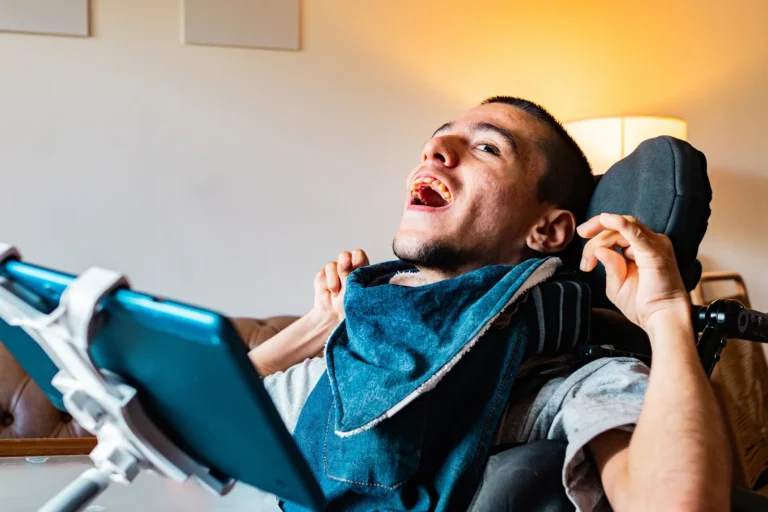It’s no secret that being around animals can make you feel happier. But did you know it can also be used as a clinical therapeutic tool?
In fact, there are therapies involving activities with horses that are collectively called equine assisted therapy (EAT). These relatively new options can support the wellbeing and recovery of both children and adults.
Let’s take a closer look at equine assisted therapy, how it may help some people with a disability and if you can access funds for this type of therapy using your NDIS Plan.
What is equine assisted therapy?
Equine assisted therapy covers a range of activities where a therapist uses a horse as a tool to support participation (for example, to help the person remain calm or improve focus or regulation) or to undertake activities like walking, standing and balancing. It can include therapy based programs working with an allied health professional, such as an occupational therapist or psychologist.
Equine assisted therapy and the NDIS.
There’s often confusion between equine assisted therapy and equine therapy but only one may be funded under the NDIS.
Equine assisted therapy: In line with NDIS guidance on animal assisted therapies, Equine assisted therapy (EAT) must be delivered by a qualified allied health professional as part of a structured, goal-focused program. It uses interactions with horses to support specific therapeutic outcomes linked to a person’s NDIS Plan goals.
The NDIS may fund evidence-based therapy supports like equine assisted therapy and equine assisted learning if they’re considered reasonable and necessary. To be an NDIS funded support, the therapy must help a person improve or maintain their functional capacity in areas such as communication, personal care, mobility, social interaction, psychosocial functioning and community participation.
Equine therapy (or animal therapy), typically refers to general activities with horses for recreation, enjoyment or wellbeing. Equine therapy is not considered a structured clinical intervention or evidence-based so is not funded by the NDIS.
What needs to be in place for NDIS funding.
Equine assisted therapy may be funded through an NDIS Plan if it meets all of the following:
- Delivered by a qualified allied health professional
- Forms part of a structured program with therapeutic goals
- Aligns with one or more of your NDIS goals
- Is considered reasonable and necessary.
Even when these conditions are met, the NDIA may assess whether the outcomes could be achieved through other, more cost-effective supports.
Programs run by riding schools or unqualified providers will not meet NDIS funding requirements. However, if you need a support worker or assistive technology to help you attend a horse-related activity due to your disability, this may be funded separately.
Who can equine assisted therapy help?
Equine assisted therapy is suitable for people of any age and may assist people with a range of disabilities, including:
- Autism spectrum disorder
- Cerebral palsy
- Down syndrome
- Spina bifida
- Movement dysfunction
- Developmental delay
- Traumatic brain injury
- Visual impairment
- Post traumatic stress disorder
- ADD/ADHD.
What are the main types of equine assisted therapy?
1. Hippotherapy
Hippotherapy is “physical, occupational and speech therapy that utilises the natural gait and movement of a horse to provide motor and sensory input” [1]. It usually also involves an occupational therapist, physiotherapist or a speech and language therapist. Unlike therapeutic horseback riding, hippotherapy is usually connected to learning goals.
Hippotherapy can shorten recovery times, improve balance, mobility, muscle control and posture. Studies show it can increase adaptive behaviours, such as communication, self care and social interaction [2].
2. Equine assisted/facilitated learning
Equine assisted learning involves learning how to care for, groom and feed the horses. This often helps participants to improve self-awareness and discover how non-verbal communication might affect interactions with other people in their lives
3. Equine assisted psychotherapy
Mental health professionals use horses to help participants learn about themselves and discuss feelings, patterns and behaviours. The goal of this type of therapy is to help in social, emotional, cognitive and behavioural ways. Equine assisted psychotherapy should always be provided by a qualified mental health professional.
What are some of the benefits of equine assisted therapy?
Equine assisted therapy can help some people with cognitive, physical, emotional and social wellbeing, depending on the type of therapy.
Cognitive benefits
- Attention span
- Concentration
- Motor planning
- Tactile awareness
- Sensory integration.
Physical benefits
- Muscle tone
- Strength
- Endurance
- Posture
- Balance
- Range of motion
- Coordination.
Emotional and social benefits
- Self esteem
- Self confidence
- Self reliance
- Improved judgement.
Why horses and not other animals?
Horses have been shown to behave in surprisingly human-like ways, especially in how they respond and relate to others. Riders and participants often find it easy to connect with their horse, as the animal mirrors their emotions.
Just being near horses or stroking them can reduce stress and anxiety levels and bring a sense of wellbeing.
“Being around horses can help people to learn self control of their behaviour and self regulation of their emotion,” says The University of Newcastle’s Dr Kirrilly Thompson in The overlooked benefits of being around horses [3].
Leap in! can help.
If you need help understanding your NDIS Plan or using your supports, the Leap in! Crew is here to help. Call us on 1300 05 78 78 or chat with us online.
Originally published 06 February 2020, updated 18 November 2021, 12 July 2022 and 7 October 2025.
[1+2] Tuba Tulay Koca and Hilmi Ataseven, NCI, What is hippotherapy? The indications and effectiveness of hippotherapy, 15 January 2015
[3] Dr Kirrilly Thompson, Horses and people, The overlooked benefits of being around horses, November/December 2019.


